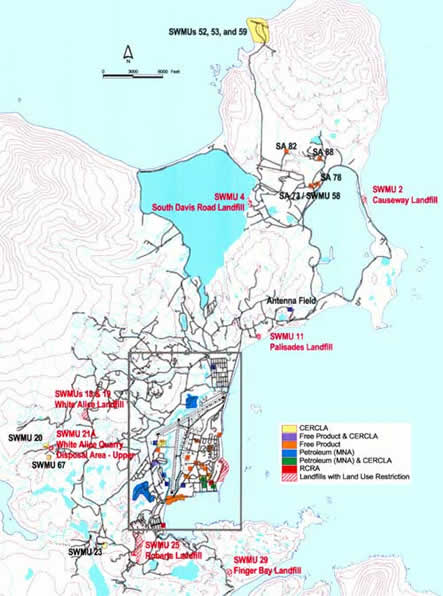The former Adak Naval Air Facility occupies approximately 76,800 acres on Adak Island and is part of the Alaska Maritime National Wildlife Refuge. In 1994 the base was added to the National Priority List of contaminated sites, under the terms of the federal Comprehensive Environmental Response, Compensation, and Liability Act (CERCLA). The air station’s military mission ended on March 31, 1997, and the base was closed that year under the Base Realignment and Closure Act (BRAC).
Through military operations over the years, releases of hazardous chemicals occurred via spills and historical disposal practices. The Navy has identified numerous sites with contamination from past Air Facility activities. Since the military mission ended in March 1997, the Navy has been involved in the environmental restoration, cleanup and closure activities as the responsible party, following the federal CERCLA standards for protecting people, animals, and the environment. DEC oversees the cleanup to assure it meets the State of Alaska standards for protection of human health and the environment. The Environmental Protection Agency (EPA) also oversees the cleanup. The Navy, DEC and EPA seek community involvement via a Restoration Advisory Board, run by the Navy. – Alaska DEC
There were 181 sites listed or evaluated for chemical and/or petroleum contamination under Operable Unit A at Adak. Contaminants included petroleum, metals, pesticides, and volatile organic compounds. Contamination was identified in soil, surface water, sediment, and as free phase or dissolved contaminants in the groundwater. Fuel tanks and lines, drum disposal areas, spill sites, pits for waste oil disposal/firefighting training, and several landfills made up the majority of chemical and petroleum contaminant sources on the island.
Over 200 potential UXO sites have been identified under Adak’s OU B. This contamination is primarily a result of World War II munitions storage, handling and training. Unexploded ordnance (UXO) represents safety as well as environmental risks when left in place, however, finding and removing it can be extremely difficult. Restrictions on access and future use of the land are commonly used to protect people and the environment from UXO.
Current Contaminant Status:
Most sites with chemical contamination on the former installation have been investigated and remediation has been completed or is in progress at all but two sites.
ATSDR Public Health Assessment summary:
Three exposure situations pose a public health hazard and require intervention in order to reduce the hazard. They are (1) exposure to lead in the tap water in Sandy Cove and Eagle Bay homes containing lead plumbing, and (2) physical hazards posed by debris, Rommel stakes, and possible unexploded ordnance throughout the downtown area and (3) the remote areas.
The maximum population was nearly 100,000 troops and 100 ships in 1943 just before the U.S. reclaimed Kiska and Attu. In 1953, after the Navy took over all facilities, 15 officers, and 176 enlisted were assigned to the base. By 1966, there were 995 military and civilian personnel on Adak. In 1973, there were 1,054 people and in 1981 the Naval Complex consisted of 2,000 persons. In 1990, the Naval Complex was occupied by 5,600 people (2,800 military)(URS 1997a).
In January 1997, the military mission of NAF Adak was terminated. By March 31, 1997, most military personnel had left. April 1, 1997, Adak entered into caretaker status with a staff of 10 Navy personnel and approximately 200 civilians as contractor employees. In March 2002, the last Navy personnel left Adak Island. Approximately 50 personnel from the Adak Reuse Corporation, its subleases, and the city of Adak operate the infrastructure. Adak Fisheries has 40 – 120 seasonal employees, and the Aleutian Regional School District has 7 personnel and 25 students.
 *For more, please read this document: ATSDR Public Health Assessment on Adak Air Force Base
*For more, please read this document: ATSDR Public Health Assessment on Adak Air Force Base
Remediation and Cleanup Contacts:
DEC Contaminated Sites contact: Guy Warren, (907) 269-7528, Fax (907) 269-7649 (Anchorage)
U.S. Navy contact: Justin Peach, Remedial Technical Manager for Adak, Naval Facilities Engineering Command – Northwest, 1101 Tautog Circle, Suite 203, Silverdale, WA 98315, (360) 396-0082
U.S. EPA contact: Christopher Cora, Remedial Project Manager for Adak, Office of Environmental Cleanup, Environmental Protection Agency, 1200 Sixth Ave., Mail Stop ECL-115, Seattle, WA 98101, (206) 553-1478, Fax (206) 553-0124 / 0957
RAB Community Co-Chair: Esther Bennett, P.O. Box 1871, Adak, AK 99546
Other Relevant Links:
- Full PDF from Alaska DEC Report: https://dec.alaska.gov/spar/csp/sites/docs/Printable%20Adak.pdf
- Navy website on Adak: http://www.adakupdate.com/
- Other EPA information: About CERCLA, About the Superfund.
- Final Finding of Suitability to Transfer (FOST) Parcel 1A, Parcel 1B, and Addendum to Final parcel 1A, link to Navy’s website
- Aleutian Reuse Committee of The Aleut Corporation website on Adak: http://www.alaska.net/~vwadak/
- US EPA’s website on Adak cleanup
- Remedial Investigation/Feasibility Study report, 2001, link to Navy’s site
- DOD Restoration Advisory Board Handbook: http://dec.alaska.gov/spar/csp/docs/rab_rule_handbook_Jan07-v2.pdf
Click to Subscribe to the Civilian Exposure Newsletter for Latest News & Updates Today!

